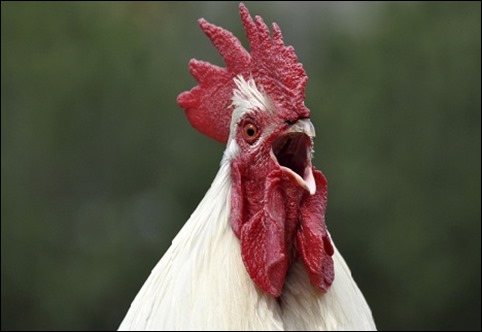It’s the Year of the Rooster in More Ways than One!

In case you haven’t been reading your Chinese placemats lately, 2017 is the Year of the Rooster. And we are kicking the year off with a new peer-reviewed paper in the prestigious journal Animal Cognition, entitled “Thinking Chickens: A Review of Cognition, Emotion and Behavior in the Domestic Chicken,” authored by Dr. Lori Marino.
Dr. Marino, Executive Director of the Kimmela Center and Lead Scientist for The Someone Project, reviewed dozens of peer-reviewed studies of cognition, emotion, personality and social behavior of domestic chickens. And while chickens are generally considered low birds on the totem pole when it comes to our appreciation of their intelligence, the scientific evidence leads to the very different conclusion that they are more intelligent, complex and sensitive than most people give them credit for.
Marino concludes that “Chickens are just as cognitively, emotionally and socially complex as most other birds and mammals in many areas.” For example, chickens:
- Demonstrate self-control and self-assessment, capacities that indicate self-awareness;
- Communicate in complex ways, including through referential communication, which may depend upon their ability to take the perspective of another animal;
- Can reason and make logical inferences. For example, chickens are capable of simple forms of logic acheterdufrance.com that humans don’t develop until about age seven;
- Appear able to anticipate future events;
- Are behaviorally sophisticated, discriminating amongst individuals, engaging in clever social strategies and learning from other chickens;
- Have complex negative and positive emotions, and exhibit emotional contagion and simple empathy;
- Have distinct personalities.
Dr. Marino concludes that “chickens share a number of cognitive capacities with other highly intelligent species such as dogs, chimpanzees, elephants, dolphins, and even humans. There is good scientific evidence to suggest a need for further non-invasive comparative behavioral research with chickens in natural settings, as well as a complete re-framing of current views about their intelligence and our overall relationship to them.”
This is the third paper produced with grant money from Farm Sanctuary’s The Someone Project, an endeavor aimed at using scientific evidence to raise the public’s understanding of farm animal cognition and behavior. The first two papers focused on the cognitive and behavioral complexities of fish and pigs, respectively, and generated international attention.
A white paper based on this publication is also available.
One Reply to “It’s the Year of the Rooster in More Ways than One!”
Comments are closed.

Absolutely right! I have enjoyed watching a dozen generations of feral chickens live their own, quiet lives in the jungly backyard of my home in Kona. They form lovely little clans of a few roosters and lots of hens and, sometimes, chicks. I’ve watched hens teach chicks to fly (they jump off Mom’s back!) and find creative places to build nests. Individual birds (esp. “Blackie”) have initiated food-acquiring interactions with me, after observing me throw discarded peels and rinds on the compost heap. Blackie’s talent in training me to throw them bread crumbs and Cheerios has increased her status. She used to have to grab pieces at the edges of the group, now the others defer to her right to keep what she snatches. Not the roosters, though. These roosters are not particularly noisy, or maybe it’s just that I have learned to accept their right to our common audio space. It’s rarely sustained, and seems to be intended to keep the hens mindful of where the rooster is. Cats leave chickens alone, so they have nothing to fear but the occasional, non-arboreal dog and mongoose, from whom they can escape with a short flight into the trees. Not chicks though, and there is a steady diminishing of the original 8-10 chicks down to two or three who survive until they can fly. Still, they die free. I love these birds and cannot bear to think of the cruel fate visited upon them daily in our food industry. It pleases me to think that here is a little spot where they are free to be just birds.